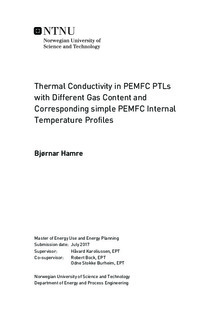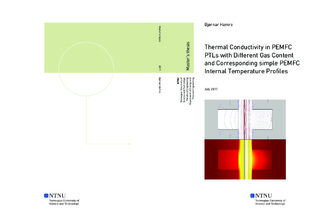| dc.description.abstract | More than 50 % of the PEMFC (Polymer Electrolyte Membrane Fuel Cell) energy is released as heat. The aim for this thesis was to contribute to the understanding of the management of that heat. The heat management in the PEMFC is largely controlled by the thermal conductivity of the subcomponents therein, many of which are porous to let gas and water move freely inside. It was theorised that the thermal conductivity of the gas in the porous materials contributes to a change in the total thermal conductivity in that porous region. As the anode side in a PEMFC is fully saturated by hydrogen, a gas with 7 times the thermal conductivity of air, this was an issue worth examining.
A new and roughly tested measurement apparatus was the base for what would become a measurement rig specialised to make the measurements needed to test the theory in this thesis. The programming of the control system had some complications and had had an unintuitive structure. The coding was cleaned up and tests were run for materials with known thermal conductivity to make sure the rig worked properly after the clean-up in the code. A gas feed system was built to provide gas to the measurement rig in a steady and secure way. The gas feed system was implemented in the coding of the rig, after which the feed properties of the gas feed system were thoroughly explored, with and without a gas preheating system. Everything about the test rig that could have been affected by the newly installed gas feed system was tested again. After many failed tests and recoding sessions, the rig was deemed fully operational together with the gas feed system. The testing started and many tests were run with earlier tested materials to make sure the rig was correctly calibrated before starting the tests that produced the thesis results.
The theorised effect was proven experimentally in this thesis by measuring the thermal conductivity of two different PTL (Porous Transport Layer) materials when saturated with air and hydrogen. Argon was also used for reference. The thermal conductivity in the PTLs increased with 20 - 25 % and 10 - 15 % respectively, depending on the compaction pressure. The material with the smaller increase in thermal conductivity had a higher thermal conductivity to start with and was, therefore, less affected by the hydrogen.
Temperature profiles were made in COMSOL to prove that the change in thermal conductivity in the PTL region made a notable impact on the heat management in the PEMFC. They also proved the importance of including the thermal effect from the hydrogen gas in future models and simulations to strengthen the validity of the results from those models and simulations. | |

